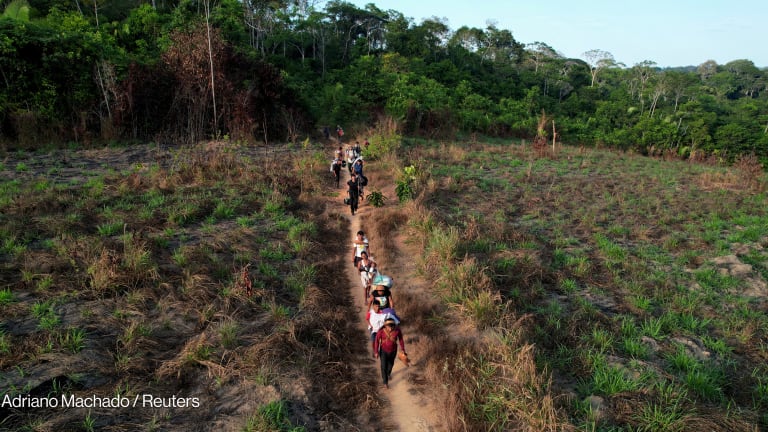
Over 50 countries launched a coalition Monday aimed at protecting at least 30% of the world’s lands and oceans by 2030, during a high-level biodiversity summit hosted by France.
This move follows a global collective failure around meeting the goals set around biodiversity in areas such as putting an end to species extinction and cutting pollution, said French President Emmanuel Macron.
“We have to face up to this failure,” he said.
Rapid loss of natural spaces globally is threatening 1 million animal and plant species with extinction. Threats to biodiversity exacerbate climate change and threaten public health, as humans encroaching on wildlife fuels outbreaks of zoonotic diseases.
Some key challenges facing biological preservation include growing populations, inadequate funding for preservation and devastating agricultural practices, as well as inadequate levels of technical expertise, political will, and coordination, according to summit participants.
Biodiversity is facing a financial gap of $711 billion per year, said António Guterres, secretary-general of the United Nations.
Opinion: We don't have to choose between food and biodiversity
"It is a false dichotomy to choose between producing food and protecting biodiversity," writes Cristiana Pasca Palmer, the executive secretary at the Convention on Biological Diversity.
Currently, only about 15% of the world’s land and 7% of the oceans are protected, but even this protection is precarious. Many of these areas are not all well managed, do not represent the totality of diversity of global ecosystems, and many of them are just too small to be viable in the long term, especially as climate change’s impacts degrade them, said Cristián Samper, chief executive officer of the Wildlife Conservation Society.
The newly launched High Ambition Coalition for Nature and People was formed in the lead up to the 15th Conference of the Parties to the Convention on Biological Diversity, which will take place this year in Kunming, China. The coalition aims to push for a global agreement on preserving 30% of land and ocean at the summit.
There is a task force within the coalition to address indigenous people and local communities’ concerns in the global negotiations on an agreement.
The coalition also aims to push for nature-based solutions within the United Nations Framework Convention on Climate Change and the adoption of key areas such as sustainable management of protected and conserved areas, increased public and private financing, and better implementation methods for preserving biodiversity in the post-2020 global biodiversity framework at COP15.
Countries hope to meet this 30% target by expanding areas under protection, combating deforestation and desertification, reducing the use of pesticides, targeting illegal fishing, protecting coastlines, and creating effective legal frameworks aimed at protection, among other efforts.
Some key tactics to achieve this are to reduce and re-direct subsidies that support industries that are harmful to diversity, increase public-private partnerships, and use existing resources more effectively, said Norwegian Prime Minister Erna Solberg.
Agriculture is a key culprit around deforestation, so channeling finance to support the livelihoods of smallholders through payment and incentive schemes is important, as well as technical training and support of social enterprises through sustainable finance, said Marco Lambertini, director-general of the World Wide Fund for Nature International.
A key project elevated during the summit was the Great Green Wall of Africa, which is working to contain desertification in the Sahel region — one of the most vulnerable areas to desertification in the world. The project stretches 8,000 kilometers (5,000 miles) from Senegal to Djibouti, crossing 11 countries, and includes the planting of trees and grassland, and other projects aimed at protecting ecosystems. Its goal is to restore 100 million hectares (247 million acres) of land by 2030 and create 10 million jobs.
At the summit, $14.33 billion was committed to Africa’s Great Green Wall, along with the announcement of an accelerator initiative to coordinate this incoming funding, surpassing the summit’s target of $10 billion. About $33 billion is needed to implement the massive project by 2030. The funds pledged on Monday include $6.5 billion from the African Development Bank.
Funds will be directed towards investments in small- and medium-sized farms, strengthening value chains and local markets, organization of exports, land restoration, management of ecosystems, climate-resistant infrastructure, access to renewable energy, government structures, and capacity building.
Limited progress over the past decade on implementation of the wall reveals a need to change the way in which the finances allocated to the initiative are managed, said Abdoulaye Dia, executive secretary of the Pan African Agency of the Great Green Wall. Better coordination of the efforts of various multilateral and bilateral bodies is important, but governments also need to show greater participation, with the technical capacity of national agencies increased. Debt sustainability of countries needs to also be considered — ideally, 60% of financing for the initiative is from donor and the rest as concessional funding.
Summit participants also discussed the role of the consumer in working to maintain biodiversity. Pascal Canfin, chair of the committee on the environment, public health and food safety at the European Parliament, said that the European Commission will introduce the first European law in June that will work to minimize the risk that imported products placed on the European market are linked to deforestation in other regions of the world.








